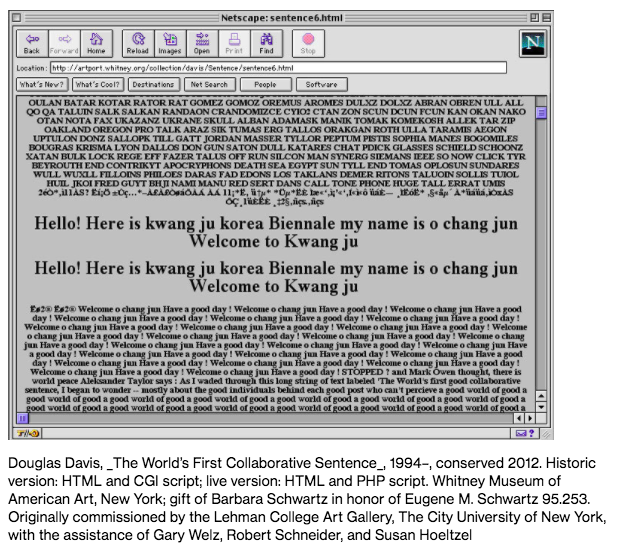The World’s Longest Collaborative Sentence (1994) by Douglas Davis.
Born in Washington DC 1933, Douglas Davis was an artist, critic, professor and author. He played an active role in the field of contemporary art since 1960. One of his first few artwork, he set up a live satellite performance through the use of interactive technology as a medium for art and communications, marking his first step into the use of the Third space.
Together, Davis and the audience constructed an interactive piece in the Third space, known as “The World’s Longest Collaborative Sentence” for a survey exhibition of his work in 1994. In 1995, this piece was donated to the Whitney Museum of American Art in New York as an Internet art. This allows the viewers and visitors to contribute to an on-going collaborative sentence.
“The Sentence has no end. Sometimes I think it had no beginning. Now I salute its authors, which means all of us. You have made a wild, precious, awful, delicious, lovable, tragic, vulgar, fearsome, divine thing.”
—Douglas Davis, 2000
By using the web as a medium, this suggests that there is no limit and restriction to what people could say or express; which infers that people may be bolder in terms of what they post since they are hiding behind a screen where there is no physical contact. As mentioned in class, when we are able to see the other party’s facial expression and emotion, it is harder to say things directly compared to an indirect form online where we are not faced physically.
In this piece, you can find both positive, neutral or negative comments, such as people publicising love to their friends or partners, or expressing random words or sentences, or even ranting about their bosses. Moreover, because this piece is posted online, this implies that it is accessible globally. You can see greetings from users in other countries! Thus, the use of the third space and the contribution of the users are unbelievable! With the network of connections branching out to users in different space and uniting each other all in one space, is the magic of the Third space. Audiences collectively collaborate and compromise, highlighting DIWO, gradually interlinking the audience and the art piece together.
On the other hand, the software used in this piece had several errors where they had to reboot the piece, which may disrupt the ‘on-going’ collaborative sentence. Nonetheless, I think that this interactive piece was created to explore and examine how people interacted collaboratively in the third space (also known as the web) with the freedom given, no matter the space they are in.
“I DID NOT FEEL SEPARATED I FELT VERY CLOSE EVEN THOUGH WE WERE THOUSANDS OF MILES APART AND I WAS SURROUNDED BY PEOPLE HERE I FELT CLOSE . . . ”
SOURCE USED:
http://whitney.org/Exhibitions/Artport/DouglasDavis
https://www.eai.org/artists/douglas-davis/biography




Very good piece, excellent research, and great description of the work. I would have liked to have seen you though comment on how this is an example of a “collective artwork,” and to use a reference/quotation from the assigned chapter on the Collective Artwork from my essay Open Source Studio. However, you presented a very compelling analysis of the work, it’s contents, and the collective process of users from around the world able to collaborate on a single sentence. And good research for uncovering Douglas Davis’ earlier work using satellite technology.